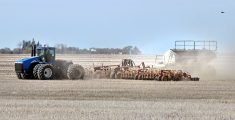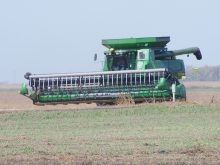LONDON, Ont. — Farmers have an obligation to address climate change, said speakers at a recent ecological farming conference.
The way to do that is to build soil health, according to University of Vermont soils expert Heather Darby and long-time Ontario organic farmer Ken Laing.
“There are all kinds of meetings like this happening and we have a better chance of changing the world than the people who met in Paris at the climate talks last week,” Darby told the Ecological Farmers Association of Ontario conference.
Read Also

Farming Smarter receives financial boost from Alberta government for potato research
Farming Smarter near Lethbridge got a boost to its research equipment, thanks to the Alberta government’s increase in funding for research associations.
“The food system has to be more than about cheap food.”
Laing said a 2.5 percent increase in carbon content in the world’s agricultural soil would go a long way toward resolving the issue.
“You can challenge my math and calculations, but this is pretty hopeful,” he said.
Human releases of carbon dioxide, nitrous oxide and methane over the past two centuries — with agriculture among the heavy contributors — have led to the unprecedented spike in their levels, Laing said.
For example, carbon dioxide levels fluctuated because of natural influences over the past million years but never exceeded 300 parts per million until the 20th century.
Laing has managed to increase soil organic carbon levels on his own farm near Sparta by a percentage point over the past 30 years. He might have achieved more had he been better informed from the start, he added.
A soil component that’s central to soil structure had yet to be discovered when he began farming.
It was only in 1996 that U.S. Department of Agriculture scientist Sara F. Wright identified globalin, Laing said.
It’s produced in the soil and roots by the hyphae and spores of arbuscular mycorrhizal fungi and is often described as the glue that holds soil together.
Laing and Darby feel agriculture should move toward a system that is much less reliant on chemical fertilizers and other crop management tools that they say have a negative impact on soil biology.
Central to this would be a return to mixed farming enterprises with crops and livestock.
These would combine the nutrient recycling of the past with today’s far greater understanding of the intricate interaction between plants and soil organisms.
The problem with chemical nitrogen fertilizers is that they interfere with delivery of organic forms of nitrogen to plants through mineralization, Darby said. In simple terms, biological relationships are compromised when crop plants have a smorgasbord placed in front of them.
“It’s not about just feeding your plant. It’s about having good soil to do the job for you,” she said.
Darby said agronomic changes may also increase the number of farmers and foster an improved relationship with the broader society.
“We’ve been on this trend, this bigger and cheaper trend, for decades. What’s that’s done is that we’ve lost a lot of farmers, which is really sad,” she said.
“We’ve taken animals away from crop production, but really they need to be closely intertwined and that’s easy to do when you have a local food system.”
Laing and Darby offered other soil-building suggestions, such as increasing plant diversity through wider rotations and the extensive use of green crops and cover crops, using manure, keeping the soil covered and reducing or eliminating tillage.
Darby said most soil and crop requirements can be addressed by the good practices with which most farmers are already familiar.
She is not a big fan of biological sprays as a short cut to crop health and said organic matter is central to the physical, chemical and biological aspects of soil, of which there are three types:
- living organic matter, plants and soil organisms
- recently dead organic matter
- long-dead organic matter or humus
“It’s not that important for me or for you to understand the function of every microbe in the soil,” she said.
“What you need to know is, if you build it, soil organic matter, the microbes will come.”
Providing a diverse array of organic matter, as opposed to what Darby described as a white bread diet, will lead to a diverse array of soil organisms.
Limiting tillage is important to help maintain mycorrhizal fungal organisms, and care needs to be taken to maintain the right balance of soil nutrients.
For example, Darby said many of the organic vegetable operations in Vermont have applied generous amounts of compost made with poultry manure, which has led to excess levels of phosphorus.
In addition, some organic farmers have made the mistake of adding too much carbon to the soil in forms such as straw or horse manure with sawdust. There’s a long-term benefit, but crops are likely to be shorted of their nitrogen requirements in the short term, she said.
Another fundamental consideration is pH. The ideal range is from 6.2 to 6.8 for optimum access to the full range of nutrients required for soil and plant health.
Darby and Laing feel that a concerted effort to build soil carbon levels can turn back climate change if there’s enough time. In the short term, it can help protect what’s already there.
Darby showed a photograph of a conventionally managed corn field in Vermont that was stripped of corn and its topsoil by one of the increasing number of storms in the region.
“We have to take care of our soils to build resiliency to these weather events,” she said.
“Good soil allows us to grow crops with less cost, in terms of money and the environment.”

















